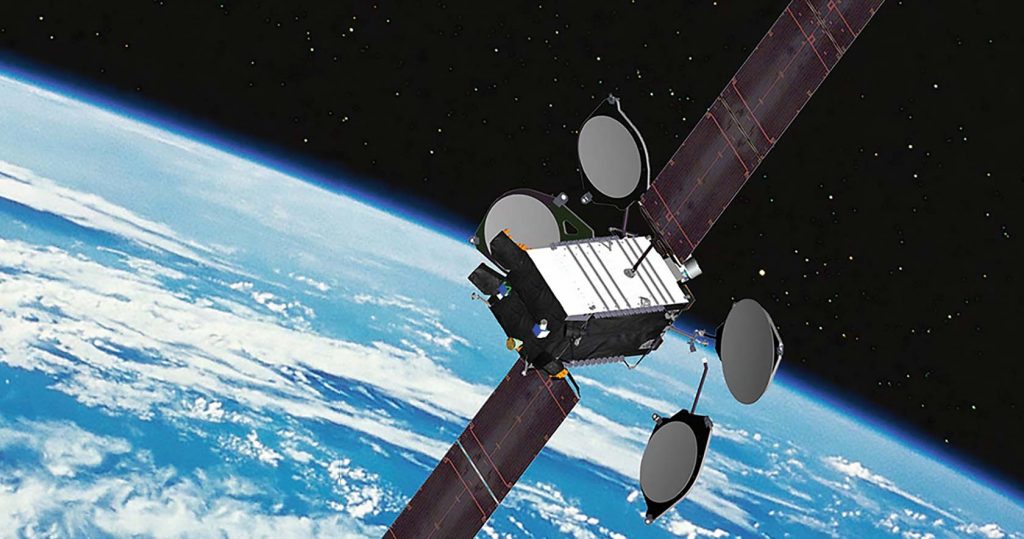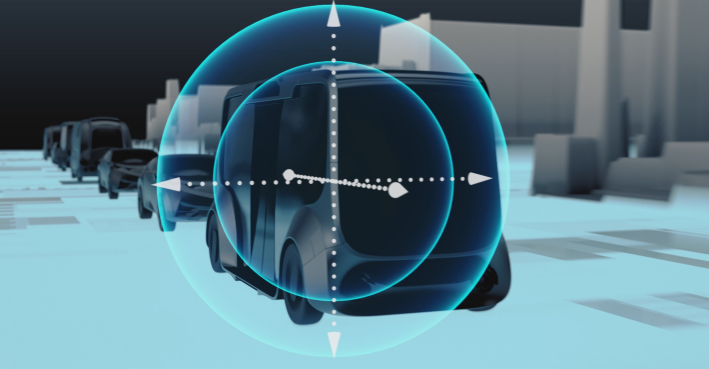
At his keynote during the HxGN LIVE Global 2022 event in Las Vegas, Michael Ritter, president of Hexagon’s Autonomy & Positioning division, gave an overview of assured positioning and demonstrated how it provides the foundation for safe autonomy.
The world is on a fast track toward an autonomous future. From off-road tractors and rural transit systems to aerial vehicles and space exploration, automation will enhance safety, increase efficiency and improve people’s lives.
To make the autonomous future safe and secure, manufacturers and operators will need reliable, assured positioning, said Michael Ritter, president of Hexagon Autonomy & Positioning division. During his keynote at last month’s HxGN LIVE Global 2022 event in Las Vegas, he gave an overview of assured positioning and demonstrated how it provides the foundation for safe autonomy.
Assured positioning’s role in autonomy
Ritter explained how positioning technologies can enable the future of autonomy for high-precision positioning across industries including agriculture, mining and automotive.
“We’ve all heard about autonomy,” he said. “What’s one of the big problems there? It doesn’t always work as advertised.”
He mentioned Tesla’s AutoPilot as an example.
“In our industry, the non-consumer world, we can’t have that,” he added. “We need to have autonomy solutions that we can trust.”
One of the biggest factors in assured autonomy is accurate positioning data, Ritter said.
“If that is not a hundred percent waterproof, crystal clear, and protected from outside interference and cybersecurity threats, you can’t trust that position,” he said. “We have to know where we are at all times, and we cannot have that signal falsified.”
Building on the sustainability theme of the earlier keynote from Hexagon’s President and CEO, Ola Rollén, Ritter said a good way to become more sustainable is by taking operators out of the loop, especially for applications such as mining, material movement and agriculture “where operators have to do the same task over and over again… The more we can automate, the more we can protect their life and happiness.”
Autonomy challenges
While Ritter doesn’t think he’ll see the universal use of autonomous vehicles in passenger traffic during his lifetime “because legislation will be in the way,” he said applications in “off-road autonomy—construction, mining, material transportation and agriculture—[are] here today.”
Hexagon is working with many customers on semi-autonomous solutions for those applications.
“Those all take place in confined spaces that are controlled; legislation is not such a big problem,” he said. “This is happening right now. We don’t have to wait 10 [to] 20 years for that.”
However, a big safety challenge in expanding autonomy is anticipating all the corner cases, or “all the stuff that could happen once in a lifetime,” Ritter said. Those can be overcome by real-life testing, multiplying that with simulation “a hundred million times over,” and then going “back into real life” and performing “real, extreme testing.”
The breadth of Hexagon’s experience helps in this regard, as more extreme applications can benefit other, less-extreme use cases. Ritter gave an example of a fighter jet, which places extreme demands on acceleration, deceleration, GPS and inertial systems.
“If you survive [in those conditions], then odds are [systems] never will fail while seeding or spraying in an agricultural environment or having an autonomous loader somewhere in an ore-loading operation,” he said.
Real-world solutions
Hexagon has a lot of experience with autonomous systems, a fact most people don’t realize, Ritter said. For example, in the U.S. and Europe, Hexagon technology is the backbone of the SBAS (satellite-based augmentation system) that allows airplanes to better use GPS to operate autonomously.
“It’s in everyday use,” he said. “It’s mandated in certain airports, and it’s used by a lot of different aircraft.”
In 2020, Hexagon announced shipment of next-generation ground uplink station (GUS) signal generators in support of a U.S. Federal Aviation Administration (FAA) contract for its WAAS (Wide Area Augmentation System) navigation service.

In 2020, Hexagon announced shipment of next-generation ground uplink station (GUS) signal generators in support of a U.S. Federal Aviation Administration (FAA) contract for its WAAS (Wide Area Augmentation System) navigation service.
Developed by the FAA for civil aviation, WAAS is a safety-critical navigation aid that provides integrity monitoring and differential corrections for all phases of flight. Along with GUS modernization, the contract includes ongoing engineering support services for the portfolio of Hexagon’s NovAtel ground reference receiver products deployed by the FAA.
Hexagon solutions have achieved success a little further up—in space—where that environment brings other big equipment challenges. One side of a vehicle facing the sun can get very hot, while just a few millimeters away on the shaded side it can be really cold.
“If you can master that, odds are you can master mining operations in Alaska and in the desert,” Ritter said of his company’s experience.
Space presents other engineering challenges, Ritter said. Signals from GPS satellites are very faint for earth-based applications.
In May, Hexagon’s NovAtel unit signed an MoU to collaborate with Xona Space Systems on its new Low Earth Orbit (LEO) constellation. The technology offers a new way of assuring PNT (positioning, navigation and timing) by providing stronger signals with satellites closer to the Earth and improved positioning accuracy with rapidly changing geometry.

Additional constellations and a larger number of available satellites improves visibility in cases where parts of the sky are obstructed by buildings and other obstacles. And as the threat of unintentional or malicious jamming and spoofing increases, it becomes important to consider alternative sources of PNT and resiliency methods.
Xona’s new constellation will transmit encrypted signals on two frequencies, both offering authentication, further building new levels of resilience against malicious interference. As an early adopter of Xona’s signals, NovAtel aims to demonstrate its continuing leadership in resilient assured PNT and “all source PNT” innovation.
Going more mainstream
While the universal use of autonomous vehicles in passenger traffic may be further off, Hexagon’s previous applications and experiences have allowed the company to expand to more mainstream applications, Ritter said.
One of those is an automotive GNSS positioning module designed to enable ADAS (advanced driver assistance systems) and autonomy at scale. Hexagon’s NovAtel has introduced the PIM222A, part of a new family of automotive GNSS positioning products that harness the unit’s experience delivering precise positioning in the most demanding applications for mass deployment in ADAS applications and autonomous vehicles.
Built with automotive-qualified hardware in a package that is easy to integrate, the PIM222A leverages SPAN technology from NovAtel to provide accurate position data in urban environments that challenge GNSS availability. Deeply coupled GNSS receivers and inertial measurement units (IMUs) ensure continuous availability of position, velocity and attitude, even when satellite signals are briefly blocked.

Created in collaboration with STMicroelectronics, the PIM222A module’s receiver design can be applied to low-, medium- and high-production volumes while retaining an array of feature options such as multi-frequency, multi-constellation, RTK and dual-antenna precision. The degree of slow-speed and initialization performance is maximized with the dual antenna feature, enabling the best possible positioning performance in all ADAS and autonomous driving situations.
Development kits for the PIM222A are available now for integrators in need of a positioning essentials solution for low- to high-quantity applications.

